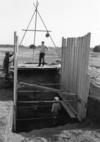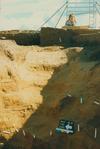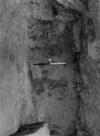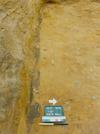The Sutton Hoo Research Project 1983-2001
Martin Carver, 2004. https://doi.org/10.5284/1000266. How to cite using this DOI
Data copyright © Prof Martin Carver unless otherwise stated
This work is licensed under the ADS Terms of Use and Access.
Primary contact
Prof
Martin
Carver
Department of Archaeology
University of York
King's Manor
Exhibition Square
York
YO1 7EP
England
Resource identifiers
- ADS Collection: 404
- DOI:https://doi.org/10.5284/1000266
- How to cite using this DOI
Downloads
Site Album : Mound 2

Leading and trailing quadrants on Mound 2 at Horizon 3, with the excavated quarry ditch in the foreground, looking south, 1987.

Excavated chamber with 16th century robbing (the oval), 19th century steps (at far end) and 1938 trench, foreground and rear 1987.



















